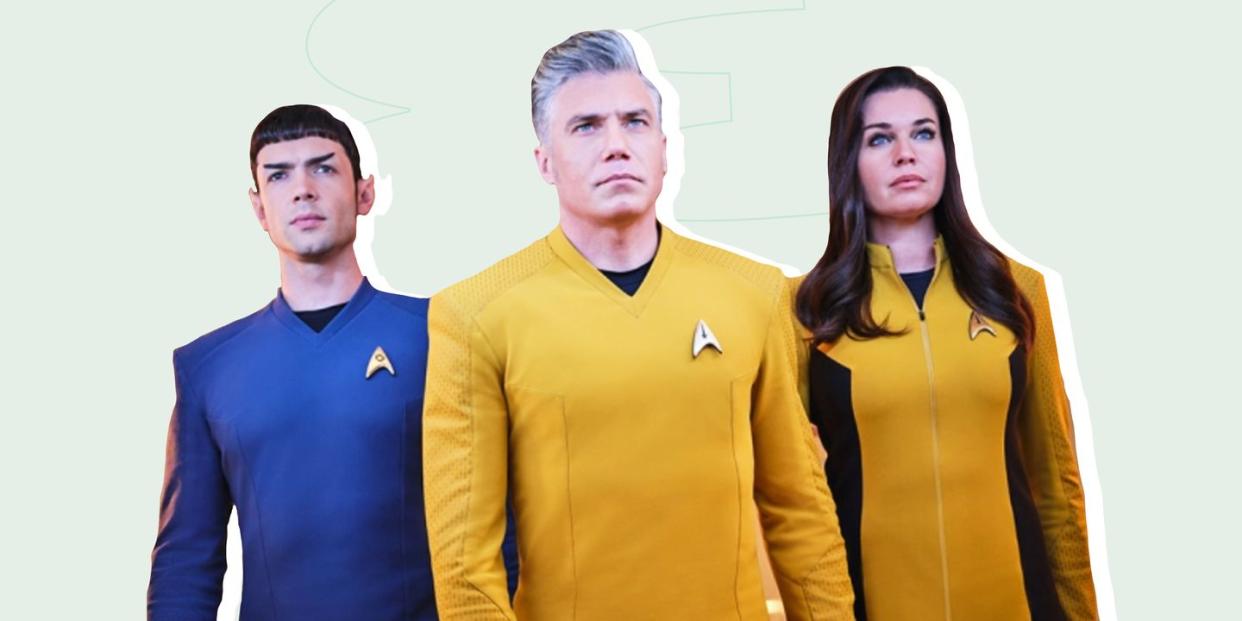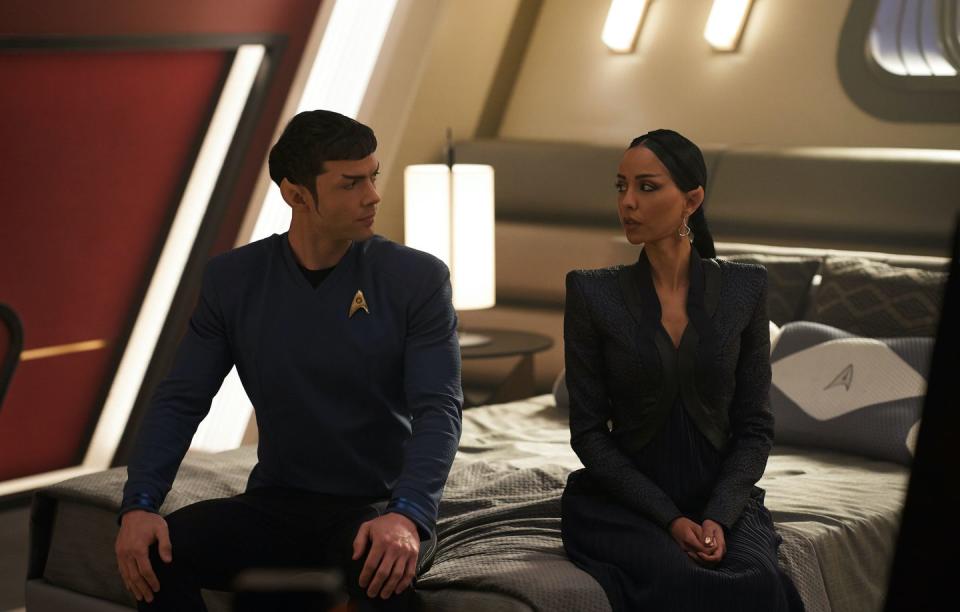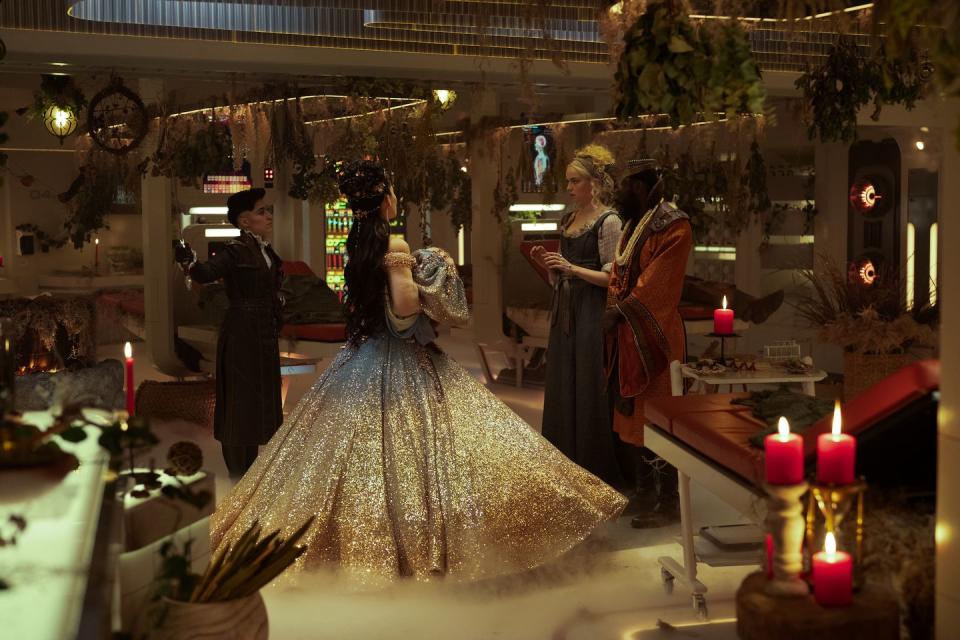You Can't Bring 'Star Trek: Strange New Worlds' Down

During the Golden Age of Streaming, most science fiction television has had one thing in common: it’s all about serious, stone-cold, high stakes drama. Take Westworld, for example—has anyone ever cracked a smile on that blasted show, or were they all too busy worrying about the fate of sentient life? Meanwhile, over in the thick of Disney+’s sci-fi renaissance, Obi-Wan Kenobi and The Mandalorian have cute kiddos up their sleeves, but somehow the little ones are always in mortal danger. Black Mirror occasionally edges into black comedy, but for every single chuckle it induces, viewers get two dystopian nightmares in exchange. Over on Apple TV+, Foundation is constantly at fever pitch, with the future of the human race hanging in the balance week in and week out. Sure, the genre has some punchy outliers (like Avenue 5 and Lower Decks), but most of today’s televised science fiction suffers from what I call Marvelitis: the sky is always falling, the fate of the galaxy is always at stake, the space-time continuum is always in danger of splintering apart.
It’s into this grimdark landscape that Star Trek: Strange New Worlds arrives like rescue from an away mission gone wrong. Paramount’s years-long campaign to breathe new life into the storied Star Trek franchise has brought sleeper hits like Lower Decks and divisive misses like Discovery, but Strange New Worlds is hands-down Star Trek's best outing in decades.
Set during the captaincy of Christopher Pike, who preceded Captain Kirk aboard the U.S.S. Enterprise, this prequel to Star Trek: The Original Series is an episodic, character-driven thrill ride where each hour pairs a top notch sociological story with some good, clean, swashbuckling fun. So much about the series just works, from its stellar cast to its nostalgic but breathable grip on Trek lore, but what elevates Strange New Worlds from other streaming sci-fi is its insistence on sweetness and silliness. Keep your multiverses, your convoluted tragic backstories, your hyper-serialized storytelling about the end of the universe as we know it—I’ll take my sci-fi with a heaping side of hijinks.
It’s important to note that hijinks are an integral part of Star Trek’s DNA. For all its visionary ideas about collectivism, justice, and inclusivity, Star Trek has always been a deeply silly sandbox where Starfleet officers tumble into campy misadventures in between all the phaser fire. Who could forget the iconic Original Series episode when the Enterprise is overrun with furry, fast-procreating tribbles, or the Voyager banger where aliens mistake a virtual reality show for real life? These aren’t mere throwaway episodes—they’re earnest, empathetic, slice-of-life stories that air out the drafty starships with some much-needed sunlight. The franchise’s signature spirit of optimism would be diminished without them.

Strange New Worlds dives headfirst into this tradition—and even goes so far as to make a winky, meta-textual gesture at them. In one standout episode, legendary science officer Spock is ensnared in a Freaky Friday caper when a soul-sharing ritual gone wrong leads him to swap bodies with his fiancée. “I do not like hijinks,” she warns, to which Spock frostily replies, “In that we are in agreement, but it appears that hijinks are the most logical course of action.” Meanwhile, following the previous episode’s nail-biting battle, the rest of the crew heads out on shore leave while the ship undergoes repairs. Two all-work, no-play officers remain behind to complete Enterprise Bingo (a hazing ritual popular among newbies) in an attempt to prove that they aren’t “where fun goes to die,” as they’ve been nicknamed. Walking the tightrope of goofy, earnest, big-hearted fun without verging into camp or cringe is a mean feat—one that Strange New Worlds pulls off handily.
Another memorable lark nods at a classic episode of The Next Generation in which Captain Picard and his crew are transported to medieval England and forced to live out the legend of Robin Hood, tights and all. In Strange New Worlds, that formula gets a glow-up when the Enterprise, while trapped in a mysterious nebula, is somehow transformed into the setting of a fairy tale that the chief medical officer often reads to his terminally ill daughter. Only Dr. M’Benga knows that something strange is afoot—and only he can put a stop to it. Bedecked in Renaissance Faire garb, the cast members have a delightful chance to play against type, with noble Captain Pike transformed into an obsequious flunky and goody two-shoes Spock rounding out the story as an evil wizard. It’s ridiculous, over-the-top, lighthearted fun—and the last thing you’d expect from prestige sci-fi.
Don’t get me wrong: Strange New Worlds can get serious. As Captain Kirk famously said in The Original Series, “Risk is our business.” Strange New Worlds doesn’t take that maxim lightly; at times, it’s a deeply moving study of duty, sacrifice, identity, and trauma. We live in serious times, so to borrow Spock’s verbiage, it’s only logical that science fiction should be serious, too. But serious stories with serious thematic messages needn’t always be relentlessly grim. Unlike most of the sci-fi available on today’s streamers, Strange New Worlds knows when to stop pummeling viewers with relentless interstellar battles and let the story breathe. Its sillier episodes work so well because none of the levity comes at a cost to characterization; rather, they build and advance character. Spock’s body swap caper is ultimately a parable about radical empathy, while Dr. M’Benga’s storybook adventure comes to a gut-wrenching conclusion when he must make a choice: let his daughter go to live free of disease, or keep her close at potentially mortal peril. One minute, the Enterprise’s no-nonsense security chief has been transformed into a histrionic princess, and the next, we’re blinking through tears to find the tissues.
In the streaming era, it’s assumed that for science fiction to qualify as “prestige television,” it must be serious. But Strange New Worlds is having its cake and eating it too, rifling through a variety pack of blended tones and batting a thousand each time. For all its episodic “alien rendezvous of the week” goodness, the characters each have a consistent emotional through line, whether it’s M’Benga’s quest to cure his daughter or Spock’s insecurities about his half-human, half-Vulcan identity. The show understands that galaxy-ending danger isn’t the only way to develop character. Sometimes it takes a body swap to prove that your betrothed can love you for who you are, no matter what your identity may be.

Not every television show can be everything to everyone. I’m not looking for the robots on Westworld to yuk it up anytime soon—if they did, it wouldn’t be Westworld. But I am looking for more sci-fi creators to take their lead feet off the gas and lighten up. Haven’t we all had enough of murderous robots, labored multiverses, and authoritarian aliens vying for galactic domination? Part of the unique joy television provides is the opportunity to hang out for hours on end with characters we love, but I’ve got to be honest—I wouldn’t hang out with anyone on Westworld. Star Trek viewers live and die by this franchise because we love spending time with its sweet, silly, ferociously smart characters and seeing how they change amid every new danger and wonder, from interstellar conflict to Robin Hood tights. Their starships are our happy places—and that’s all because sometimes, they're truly a happy place to be.
You Might Also Like